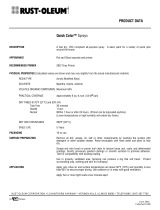
1-800-663-DOOR masonite.com
MIC-18127 / ©2018 Masonite International Corporation.
Paint/Stain order:
➊ Grilles or muntins
➋ Horizontal rails
➌ Vertical stiles
➍ Finish all edges
(see FIGURE I)
FIGURE H
BEFORE YOU PAINT/STAIN
1.
Inspect the door and sand imperfections
as needed. When sanding wood or veneer
doors always sand with the grain as seen
in FIGURE G. Use wood putty to fill holes
and wood imperfections. When using
wood putty ensure it is dry and sanded
prior to painting or staining.
2.
Doors with glass have a protective film
on the glass. If any portion of the glass is
exposed, use masking tape or painters tape
to cover the area. Do not remove protective
film until door is painted or stained.
(See FIGURE K)
3.
Wipe door down removing dust and dirt
with a tack cloth to ensure a dust free
finish. (See FIGURE H)
4.
Paint in following order for door type.
(See FIGURES L – O)
5.
If you are not using a stain with a sealer
an additional sealer will be needed on
top of the stain to seal the door. Consult
your stain supplier and follow the
manufacturer's instructions.
Front
Back
Side
Edge
Side
Edge
Bottom Edge
FIGURE J
FIGURE G
WARNING
Some issues are caused by incorrect
topcoat and/or improper coating techniques.
Masonite is not responsible for issues
related to incorrect topcoats. Always follow
the recommended instructions or the
instructions of paint or stain manufacturers.
TELEGRAPHING OR FIBER RISE
Rough or raised straw-like protrusions,
appears as a result of incorrect topcoat
(paints or stains), improper finishing
techniques and or finishing conditions.
These are caused by but are not limited
to incorrect topcoat, watered down
paints, high humidity environments,
and excessive application of paints.
DISTORTION Warping, bowing and
waviness, can appear as a result of incorrect
topcoat (paints or stains), improper finishing
techniques and or finishing conditions. These
are caused by but are not limited to incorrect
topcoat, watered down paints, high humidity
environments, excessive application of paints,
and doors not being acclimated properly.
GRAIN RAISE The visible rise of the
natural woodgrain, can be caused by but
are not limited to incorrect topcoat, watered
down paints, high humidity environments,
and excessive application of paints.
POOR PAINT ADHESION A poor
bond of the paint to the door, can be
caused by but are not limited to incorrect
topcoat, watered down paints, high humidity
environments, excessive application of paints,
and painting an improperly prepared door.
ORANGE PEELING
An orange skin-like,
can be caused by some but are not limited
to; incorrect topcoat, paint drying too
fast, and excessive application of paints.
MATERIALS NEEDED
Rubber gloves
Other personal protective gear as
needed (eye protection/ventilator)
Drop cloth
Paper towels
220 grit sandpaper and
sanding block
Tack cloths
Masking tape or painter’s tape
Stir sticks
1" High quality brush
3" – 4" High quality brush
Scraper
Putty knives
Utility knife or sharp blade
Wood filler (for wood doors or jambs)
Water based or oil based primer
(needed for sanded and unprimed
products to be painted)
Conditioner and wood sealer (to be
used when staining wood doors or
wood veneer doors for even color)
Water based or oil based top
coat (paint) – semi-gloss
Mineral spirits – for cleanup,
if oil-based paint is used
Sawhorses
FIGURE M
Paint/Stain order:
➊ Door panels
➋ Center stiles
➌ Horizontal rails
➍ Vertical stiles
➎ Finish all edges
(see FIGURE I)
FIGURE O
FLUSH VENEER
Paint/Stain order:
➊ Flush surface
➋ Finish all edges
(see FIGURE I)
HOW TO PAINT/STAIN
FIGURE L
Paint/Stain order:
➊ Start with the
louvers/panels
➋ Horizontal rails
➌ Vertical stiles
FIGURE N
PRE-PRIMED DOORS
Light sanding of pre-primed doors prior
to painting is recommended. If primer has
been removed or damaged from any part
of the door during shipping or handling,
lightly sand and re-prime the exposed
areas. Follow the primer manufacturer’s
instructions for application. If additional
primer is used, ensure the primer meets
the desired finished door results. Ensure
the primer is compatible with both the
paint and primed door.
UNPRIMED DOORS
Fill any
holes and blemishes with color matching
wood filler. All doors will require a light
sanding to ensure a uniform finish.
Remove handling marks by lightly
sanding before applying finish. Surface
should be clean and dry, free of all dirt,
grease, glue, stains and machine marks.
PAINT
Masonite recommends a
high quality semi-gloss, water-based
or oil-based paint. Consult with your
topcoat supplier for the correct paint to
work with your Masonite door. Follow
the paint manufacturers instructions.
A quality finish is achieved with a
minimum of two coats following the
paint manufacturers instructions for
drying time and application. Masonite
does not recommend dark or high
gloss paints. If a higher quality finish
is preferred additional coats and
sanding will be required following the
coating manufacturers instructions.
STAIN
Masonite recommends a high
quality water-based or oil-based stain.
Follow the paint or stain manufacturer’s
instructions. Do not thin stain with water
or other chemicals. If humidity is high or
dicult to control, high quality oil stain is
recommended. It is recommended to test
stains and paint on wood doors to ensure
an acceptable finish. Finished doors must
be allowed time to dry in accordance
with the paint or stain manufacturer’s
recommendations.
FIGURE I
Read all instructions thoroughly before beginning. This is a guideline for painting and finishing interior doors.
Consult a paint professional or local paint department/store for coatings best suited to the project.
FINISH YOUR WOOD, FRENCH, LOUVER & WOOD VENEER DOORS
FRENCH
WOOD PANEL
WOOD LOUVER
FIGURE K
MIC-18127-INT-Finishing-Instructions.indd 3 7/20/18 2:02 PM







